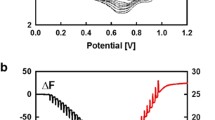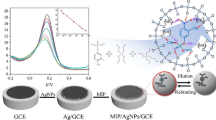Abstract
A molecularly imprinted system is introduced here whose color gradually changes as the analyte becomes rebound. The MIP was prepared from an acryloyl-modified β-cyclodextrin (β-CD), acrylamide (AAm), and N,N′-methylenebisacrylamide (MBAA), and imprinted with bisphenol A (BPA). The sensing capability of the MIP was first tested by potentiometry. A spin-coated gold plate coated with the MIP was used as a working electrode; the electrode can differentiate BPA from phenol or p-cresol, which were used as analogs of BPA. Next, a color-responsive system was fabricated by forming a hydrogel membrane containing the modified β-CD, AAm, and MBAA. A vesicle solution was prepared from N-(2-aminoethyl)pentacosa-10,12-diynamide by sonication and incorporated into the hydrogel. The blue polydiacetylene was formed by UV photopolymerization. In the presence of BPA, this system undergoes a color change from blue to red that is proportional to the degree of BPA rebinding. The color change is due to the contraction of the gel membrane that rebinding causes. The method works to 0.5 mM BPA concentration range. The detection limits for BPA are 0.1 mM on visual assessment and 50 μM on spectrophotometric readout.

A molecular imprinting system is described whose color changes from blue to red as it binds bisphenol A. The degree of rebinding can be measured by detecting the color change of polydiacetylene vesicle. CD: cyclodextrin, BPA: bisphenol A.






Similar content being viewed by others
References
Chen L, Wang X, Lu W, Wu X, Li J (2016) Molecular imprinting: perspectives and applications. Chem Soc Rev 45:2137–2211
Wulff G, Liu J (2012) Design of biomimetic catalysts by molecular imprinting in synthetic polymers: the role of transition state stabilization. Accounts Chem Res 45:239–247
Pan J, Chen W, Ma Y, Pan G (2018) Molecularly imprinted polymers as receptor mimics for selective cell recognition. Chem Soc Rev 47:5574–5587
Yang Y, Meng X, Xiao Z (2018) Synthesis of a surface molecular imprinting polymer based on silica and its application in the identification of nitrocellulose. RSC Adv 8:9802–9811
Wang Y, Zhou Z, Xu W, Luan Y, Lu Y, Yang Y, Liu T, Li SJ (2018) Surface molecularly imprinted polymers based ZnO quantum dots as fluorescence sensors for detection of diethylhexyl phthalate with high sensitivity and selectivity. Polym Int 67:1003–1010
Korytkowska-Walach A (2013) Molecularly imprinted hydrogels for application in aqueous environment. Polym Bull 70:1647–1657
Kawamura A, Kiguchi T, Nishihata T, Uragami T, Miyata T (2014) Target molecule-responsive hydrogels designed via molecular imprinting using bisphenol a as a template. Chem Commun 50:11101–11103
DiScenza DJ, Lynch J, Feder E, Levine M (2018) Detection of bisphenol a and derivatives in human urine via cyclodextrin-promoted fluorescence modulation. Anal Methods 10:3783–3790
Üzek R, Sari E, Şenel S, Denizli A, Merkoçi A (2019) A nitrocellulose paper strip for fluorometric determination of bisphenol a using molecularly imprinted nanoparticles. Microchim Acta 186:218
Ensafi AA, Amini M, Rezaei B (2018) Molecularly imprinted electrochemical aptasensor for the attomolar detection of bisphenol a. Microchim Acta 185:265
Ren X, Cheshari EC, Qi J, Li X (2018) Silver microspheres coated with a molecularly imprinted polymer as a SERS substrate for sensitive detection of bisphenol a. Microchim Acta 185:242
Yang DH, Ju MJ, Maeda A, Hayashi K, Toko K, Lee SW, Kunitake T (2006) Design of highly efficient receptor sites by combination of cyclodextrin units and molecular cavity in TiO2 ultrathin layer. Biosens Bioelectron 22:388–392
Yang DH, Ju MJ, Maeda A, Lee SW (2008) Enhanced sensor capability of juxtaposed β-cyclodextrin rings in TiO2 ultrathin matrix as determined by cyclic surface-polarization impedance measurement. Sens Mater 20:191–200
Kang D, Jung H, Kim K, Kim J (2017) Mussel-inspired universal bioconjugation of polydiacetylene liposome for droplet-array biosensors. ACS Appl Mater Inter 9:42210–42216
Park DH, Heo JM, Jeong W, Yoo YH, Park BJ, Kim JM (2018) Smartphone-based VOC sensor using colorimetric polydiacetylenes. ACS Appl Mater Inter 10:5014–5021
Chae S, Lee JP, Kim JM (2016) Mechanically drawable thermochromic and mechanothermochromic polydiacetylene sensors. Adv Funct Mater 26:1769–1776
Lee S, Kim JY, Chen X, Yoon J (2016) Recent progress in stimuli-induced polydiacetylenes for sensing temperature, chemical and biological targets. Chem Commun 52:9178–9196
Fenzl C, Hirsh T, Wolfbeis OS (2014) Photonic crystals for chemical sensing and biosensing. Angew Chem Int Ed 53:3318–3335
Yang DH, Shin MJ, Kim M, Kim YD, Kim H, Shin JS (2016) Molecularly imprinted titania microbeads for extraction of the metabolite 1-hydroxypyrene from urine prior to its determination by HPLC. Microchim Acta 183:1601–1609
Shin MJ, Shin YJ, Shin JS (2012) Sensing capability of molecularly imprinted self-assembled monolayer using terphenylpropanethiol. Particul Sci Tech 30:543–552
Shin MJ, Shin YJ, Shin JS (2014) Sensing capability of molecularly imprinted self-assembled monolayer fabricated using dithiol compound. J Ind Eng Chem 20:91–95
Shin MJ, Shin YJ, Shin JS (2018) Cholesterol recognition system by molecular imprinting on self-assembled monolayer. Colloid Surface A 559:365–371
Shin MJ, Kim M, Shin JS (2019) Switchable cholesterol recognition system with Diels–Alder reaction using molecular imprinting technique on self-assembled monolayer. Polym Int 68:1722–1728
Shin MJ, Shin JS (2019) Effect of ethanol on the color transition of the polydiacetylene vesicle of 10,12-pentacosadiynoic acid for butylamine detection. J Appl Polym Sci 136:47688
Shin YJ, Shin MJ, Shin JS (2017) Permeation-induced chromatic change of a polydiacetylene vesicle with nonionic surfactant. Colloid Surface A 520:459–466
Shin MJ, Kim JD (2016) Reversible chromatic response of polydiacetylene derivative vesicles in D2O solvent. Langmuir 32:882–888
Kim M, Shin YJ, Hwang SW, Shin MJ, Shin JS (2018) Chromatic detection of glucose using polymerization of diacetylene vesicle. J Appl Polym Sci 135:46394
Acknowledgements
This research was supported by the Basic Science Research Program funded by the National Research Foundation of Korea (NRF-2017R1D1A3B03034089 for Jae Sup Shin, and NRF-2017R1C1B5015673 for Min Jae Shin).
Author information
Authors and Affiliations
Corresponding author
Additional information
Publisher’s note
Springer Nature remains neutral with regard to jurisdictional claims in published maps and institutional affiliations.
Rights and permissions
About this article
Cite this article
Shin, M.J., Shin, J.S. A molecularly imprinted polymer undergoing a color change depending on the concentration of bisphenol A. Microchim Acta 187, 44 (2020). https://doi.org/10.1007/s00604-019-4050-0
Received:
Accepted:
Published:
DOI: https://doi.org/10.1007/s00604-019-4050-0




